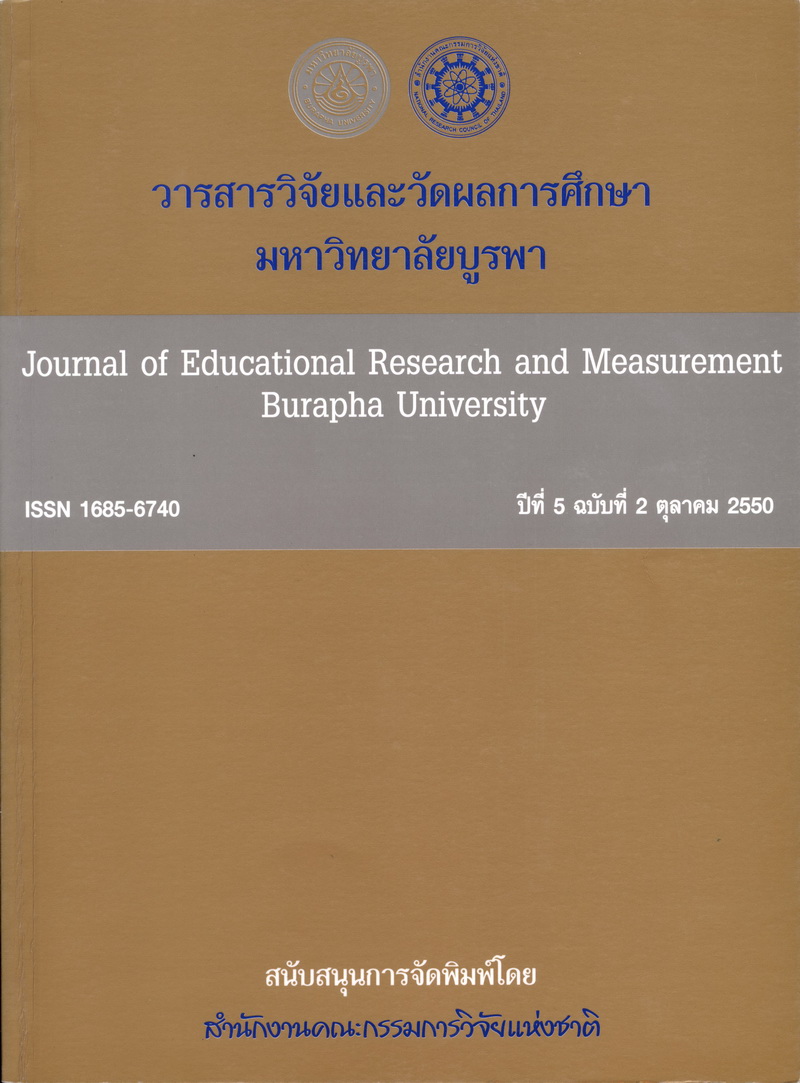การปรับเทียบคะแนนตามแนวตั้งโดยใช้แบบทดสอบร่วมภายใน: การเปรียบเทียบ คุณภาพระหว่างวิธีเชิงเส้นตรงกับวิธีทฤษฎีการตอบสนองข้อสอบ
Main Article Content
Abstract
การวิจัยนี้มีวัตถุประสงค์เพื่อศึกษาคุณภาพของการปรับเทียบคะแนนตามแนวตั้งโดยใช้แบบทดสอบ
ร่วมภายใน โดยการเปรียบเทียบความคลาดเคลื่อนและความเพียงพอของการปรับเทียบคะแนนระหว่างวิธีเชิง
เส้นตรง กับวิธีทฤษฎีการตอบสนองข้อสอบแบบสองพารามิเตอร์ กลุ่มตัวอย่างเป็นนักเรียนชั้นประถมศึกษาปี ที่
4, 5 และ 6 ในโรงเรียนสังกัดสำนักงานเขตพื้นที่การศึกษาชลบุรี เขต 3 ปีการศึกษา 2548 จำนวน 1,260 คน
จำแนกเป็น 2 กลุ่ม ได้แก่ กลุ่มปรับเทียบคะแนนจำนวน 900 คน และกลุ่มสอบทานผลจำนวน 360 คน
เครื่ องมือที่ใช้ เป็ นแบบทดสอบวัดผลสัมฤทธิ์ทางการเรี ยนวิชาคณิตศาสตร์ จำนวน 4 ฉบับ แบ่งเป็ น
แบบทดสอบสำหรับกลุ่มปรับเทียบคะแนนตามระดับชั้น จำนวน 3 ฉบับ ๆ ละ 25 ข้อ ซึ่งมีข้อสอบร่วมระหว่าง
ระดับชั้น ฉบับละ 5 ข้อ และแบบทดสอบสำหรับกลุ่มสอบทานผล 1 ฉบับ จำนวน 65 ข้อ
ผลการวิจัยปรากฏว่า
1. ความคลาดเคลื่อนของวิธีเชิงเส้นตรงมีค่าน้อยกว่าวิธีทฤษฎีการตอบสนองข้อสอบแบบสอง
พารามิเตอร์ อย่างมีนัยสำคัญทางสถิติที่ระดับ .01
2. ดัชนีความแตกต่าง (C) ของวิธีเชิงเส้นตรง มีค่าน้อยกว่าวิธีทฤษฎีการตอบสนองข้อสอบแบบสอง
พารามิเตอร์ อย่างมีนัยสำคัญทางสถิติที่ระดับ .01 แสดงว่า วิธีเชิงเส้นตรงมีค่าความเพียงพอของการปรับเทียบ
คะแนนอยู่ในระดับที่น่าพอใจมากกว่าวิธีทฤษฎีการตอบสนองข้อสอบแบบสองพารามิเตอร์
สรุปได้ว่าการปรับเทียบคะแนนตามแนวตั้งโดยใช้แบบทดสอบร่วมภายในกับแบบทดสอบวัดผลสัมฤทธิ์
ทางการเรียน วิธีเชิงเส้นตรงมีคุณภาพดีกว่าวิธีทฤษฎีการตอบสนองข้อสอบแบบสองพารามิเตอร์
Vertical Equating Using Internal Anchor Tests:A Comparative of the Relative Quality of Linear Equating and IRT Equating Methods
The purpose of this research was to study the quality of vertical equating using internal anchor items by comparing the error and adequacy of equating between linear and IRT two-parameter methods. The sample consisted of 1,260 Grade 4, 5 and 6 students in schools under the Chon Buri Education Service Area Office, Area III of academic year 2005. This sample was divided into two groups; 900 for the equating group, and 360 for the cross-validation group. The research instruments were four mathematics achievement tests, three for the equating group with 25 items (with five internal anchor items), and one for the cross-validation group with 65 items. The results were as follow: 1. The error of the linear equating method was found to be less than that of the IRT equating method at the .01 level of statistical significance. 2. The discrepancy index (C) of the linear equating method was found to be less than the IRT equating method at the .01 level of statistical significance, indicating that the linear equating method yielded results that could be more acceptable than those of the IRT two-parameter equating method. With regard to vertical equating using internal anchor items with achievement tests, the linear equating method was found to be superior to the IRT two-parameter equating method.

